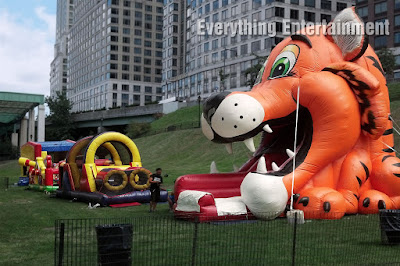Inflatables should never be “Safety First”, rather
“Safety Always”
Safety
has become the preeminent concern among the inflatable amusement
industry, as kids and parents expectations of our attractions grow, so
must the products. As the sizes grow so must our attention to the
effects the environment around the install location will have on our
equipment. In the eighties, you could only rent a Moon-Walk Bounce
House, the nineties Giant Inflatable Slides and Inflatable Obstacle
Courses were available to rent. Now there are inflatable slides that are
over three stories tall for company picnics, one-hundred foot long
inflatable obstacle courses for school carnivals, and challenging
inflatable games that add mechanical elements into them available for
college fun-days.
Taller
inflatables have a greater potential to become affected especially by
wind, swaying from side to side if not properly tethered. The proper way
to offset this concern is to ensure that all guy lines are secured at
the angle the manufacturer recommends, another trouble shooting method
is asking the manufacturer to increase the number of tie down points.
Something whoever you hire proactively does even for our low to the
ground inflatable, because you should make sure whomever you hire
believes in “Safety Always”
“All reputable manufacturers provide weight and tethering guidelines” says Scott Weisberg, President of Everything Entertainment.
Scott
has been in the business since 1988 and carries some inflatables that
require a dozen cement blocks, each weighing over eight hundred pounds.
“There have been many scary videos online of bouncers blowing away with children inside, that could have been avoided if the rental company just did what they should have done in the first place, which is follow the manufacturer's guidelines” said Scott Weisberg, President of Everything Entertainment.
Further
measures can be taken such as using stakes whenever possible, and
concrete weights on surfaces that are cannot be staked. By using cement
block in lieu of water weights, you are greatly reducing the chance for
wind gusts sliding an inflatable across surfaces such as concrete,
asphalt or turf due to the increased friction of the concrete weights
versus the smooth surface of water barrels. Secondly and unfortunately
overlooked, is sandbags are prone to rips and tears, spilling its
contents and reducing the weight with no one aware until it’s too late.
In another “Safety Always” measure, we recommend you hire a company that
uses extra durable sandbags when there is no other choice but to use
sandbags.
Properly
trained staff can considerably reduce the frequency of safety issues.
Many more issues than just wind can affect the safety of the inflatable
bounce house or slide. How power is run and where it is drawn from can
lead to fire hazards, trip hazards, and blown electric circuits. If a
cable is run to far from its source the wiring may be “working too hard”
raising its temperature as well as its potential for overheating.
Another power related concern can be overload, if too many items are
drawing power from the same source, overheating again is a risk, both
potential fire hazards. Please check that you use a company that trains
its staff in proper electrical practices, places fire extinguishers
within 6’ of every ride to ensure quick reaction to an unfortunate
situation.
By
having staff attend seminars led by industry professionals they begin
understanding how every step they take can impact the safety of the
event guests, which should always be the company you hire’s number one
priority. Understanding the importance of watching those on the ride as
opposed to just standing by, making sure rules are followed and injuries
are greatly reduced.

No comments:
Post a Comment
Note: Only a member of this blog may post a comment.